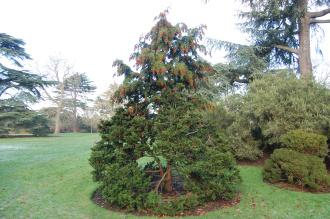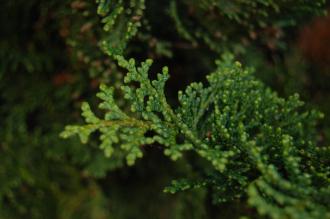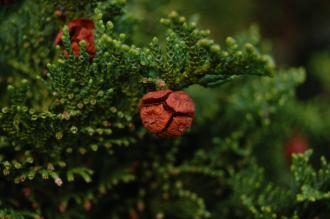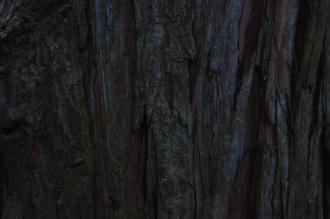
Chamaecyparis obtusa ‘Nana Gracilis’ (30/12/14, Kew Gardens, London)
Position: Full sun
Flowering period: Spring
Soil: Moist, well drained
Eventual Height: 2m
Eventual Spread: 1.8m
Hardiness: 4a, 4b, 5a, 5b, 6a, 6b, 7a, 7b, 8a, 8b
Family: Cupressaceae
Chamaecyparis obtusa ‘Nana Gracilis’ is a slow growing evergreen coniferous shrub with a conical habit. Its glossy dark green leaves are scale like, up to 4mm long and appear as flattened splays. Its red/ brown bark is furrowed and peels with age. Its flowers. Its light brown fruit are spherical cones and up to 12mm across.

Chamaecyparis obtusa ‘Nana Gracilis’ Leaf (30/12/14, Kew Gardens, London)
The species Chamaecyparis obtusa, commonly known as Hinoki Cypress or Hinoki Falsecypress, is native to Japan.
The etymological root of the binomial name Chamaecyparis is derived from the Greek chamea meaning ’dwarf’ and kupeiros the ancient Greek name for the Cypress (ironically this is not a dwarf tree). Obtusa is derived from the Latin obtusum meaning ‘blunt’.

Chamaecyparis obtusa ‘Nana Gracilis’ Seed (30/12/14, Kew Gardens, London)
The landscape architect may find Chamaecyparis obtusa ‘Nana Gracilis’ useful as a small conical shaped conifer. Once established this shrub is drought tolerant.
Ecologically, Chamaecyparis obtusa ‘Nana Gracilis’ is of little value to UK wildlife.
The Royal Horticultural Society has given Chamaecyparis obtusa ‘Nana Gracilis’ their prestigious Award of Garden Merit in 1993.

Chamaecyparis obtusa ‘Nana Gracilis’ Bark (30/12/14, Kew Gardens, London)
Chamaecyparis obtusa ‘Nana Gracilis’ prefers moist, fertile, well-drained soils. It tolerates most pH of soil, although it prefers a slightly acid soil.
Chamaecyparis obtusa ‘Nana Gracilis’ requires little maintenance.

